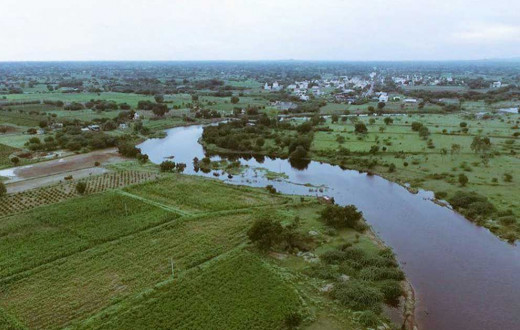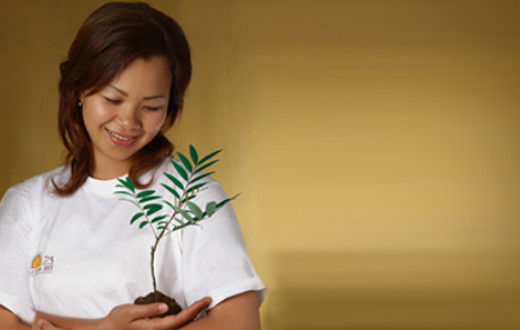Overview
“A river is a complex ecosystem,” says Dr. Lingaraju Yale, a geo-hydrologist and one of the foremost experts on natural water resource management in India. And a dying, complex ecosystem requires round-the-clock work of a committed team to breathe life back into it.
The story of the Kumudvathi river rejuvenation project is that of hope, commitment, and rigor. Since mid-2013, Dr. Yale and his team of 20-odd full-time Art of Living volunteers and few hundred part-time volunteers across four states in India have initiated their work in rejuvenating the Kumudvathi river.
“In February 2013, a large team from The Art of Living decided to take up the challenge and devote their weekends to travel to villages in the river basin to start working on the plan of rejuvenating Kumudvathi River using a scientific methodology for sustained results,” reminisces Dr. Yale.
What Dr. Yale and his team are doing is, in a sense, seminal, the fruition of which is likely to show results in pockets throughout the country.
For now, 278 villages and Bengaluru, the IT capital of India, are pinning their hopes on the revival of the 460 sq. Km Kumudvathi River.
How it began
The year 2007 saw an acknowledgment of a growing crisis: Bengaluru faced a 20 percent shortage of fresh water supply as the Thippagondanahalli water reservoir, fed by the Kumudvathi river, went dry.
This proved to be a culmination of a problem that had been accumulating for a few years and promised only to grow larger, affecting the villages through which the river once flowed.
Under the banner of IAHV (International Association of Human Values), volunteers from The Art of Living undertook the challenge of reviving the dying river.
The volunteers along with the villagers pooled the resources and participated in de-silting the neglected Kalyani (step wells) in the villages. These structures play an important role in maintaining groundwater levels. About 10 recharge wells and boulder checks were constructed using donations of volunteers to showcase them to the public at large and also to Government officials.
The Action Plan was presented to the Zilla Panchayat and the Gram Panchayats. Several meetings of farmers with Gram Panchayat members were held highlighting the importance of activities to rejuvenate the river. Zilla Panchayats understood the importance of the project and also the possibility for including the work under Mahatma Gandhi National Rural Employment Guarantee Act (MGNREGA). The sanctions were accorded for the financial outlay, and Gram Panchayats were advised to implement the proposals made by them with guidance from The Art of Living team.
Why did the river dry up?
- Urban encroachment
- Deforestation
- Quarrying
- Over-exploitation of groundwater
Why does this matter?
One day, an old farmer made a crucial decision. He decided to begin eucalyptus plantation. Why would someone, who thoroughly understands the language of the soil, choose to switch from growing food crops to medicinal plants?
He was left with no choice as he witnessed the groundwater levels decreasing rapidly. Stream networks, a nerve center of thriving agricultural produce, began to dry up too. A report suggested that up to 100 stream networks of the Kumudvathi River had dried up.
With little water available, and no choice left, the farmer decided to switch to less water-intensive crops with a hope of keeping the family’s income afloat.
This is the story of innumerable farmers whose livelihoods depended on this river’s flow. With water crisis and economic insecurity looming large, a significant number of the rural population migrated to Bengaluru in search of livelihood.
Lower levels of water translate into:
- Less agricultural produce
- Decreased water levels for daily usage
- Socio-economic instability of farmers
The good news
The positive impact of the rejuvenating activities is already visible in a few villages with 10 to 15 ft. of water standing in open wells and step wells even in summer.
Learn Sudarshan Kriya, a powerful breathing technique driving our volunteer community with vitality and focus.
It is expected that with sufficient rainfalls for a minimum of three seasons after completion of work in the entire project area, the river’s levels will be significantly higher. This has the potential to augment Cauvery's water to satisfy Bengaluru’s needs, restore environmental balance in the belt, as well as bring back families and youth who left the villages.
What did we do?
With the help of our technical team, we have worked out several strategies for this project:
- Soil erosion has been controlled by checking the speed of rainwater flow on stream paths by constructing boulder checks
- Groundwater has been recharged by constructing water recharge wells and injection wells at scientifically identified locations. These have helped to bring up the water table in the catchment areas
- Water bodies have been rejuvenated by cleaning of Kalyanis (step wells) and tanks
- Vegetation cover has been increased by planting trees. This is a long-term but permanent solution for restoring the ecosystem
- Organic farming techniques are being taught to farmers to optimize the water usage
How does the journey look so far?
- Built 436 boulder checks
- De-silted over 20 traditional step wells
- Constructed 433 recharge wells and 71 water pools
- Constructed 44 recharge borewells
- Planted more than 39,000 saplings
- Spread awareness to 66,504 people spread over 100 villages
A people’s movement
The Art of Living’s initiative, which aimed at reviving the river, has today turned into a revolution.
From volunteers gathering at the Shivaganga hills region to plant trees along the course of the river every Sunday to the Hindustan Aeronautics Limited (HAL) stepping in to fund the project, corporates, villagers, government authorities and common masses are helping in the project.
“With the support of nine Gram Panchayats and the Minor Irrigation and Water Resources Department in the restoration of existing local water bodies in the region, the project is likely to be completed soon,” said Dr. Yale.
The Art of Living’s approach towards any project is a holistic one. So, along with the rejuvenation, The Art of Living has also taken the responsibility to train villagers through empowering programs like the Youth Leadership Training Program (YLTP) and stress management programs.
The project also works with farmers, encouraging them to form farmers' clubs at the Panchayat level to take the initiative in carrying out organic farming and community farming.
What did we learn?
We have learned that in such massive projects, the key is not just investing funds. It is also incredibly important to develop a sense of ownership in the local community so that they take responsibility to make the change sustainable.
Besides, continuous dialogue with Zilla and Gram Panchayats regarding the project and its progress, it is important to share the experiences with local farmers and village beneficiaries and to involve the government bodies.
How can you contribute?
This is a complex and large project, and the following activities are planned to cover the river basin covering 18 mini-watersheds to rejuvenate the river:
- 885 recharge wells in 278 villages covering 460 sq. Km of the river basin
- 1749 boulder checks along the streams
- 54 deep injection wells needed in the river basin
- 223 water pools to be made in the lakes
- 100,000 trees to be planted in the area
It is expected that with sufficient rainfalls for minimum three seasons after completion of work in the entire project area, the desired results will be visible.
We are looking for partners who can work with us on implementation and funding for one or more mini-watersheds out of the proposed 18 watersheds. Apart from monetary contribution, participation in terms of technical expertise, writing stories and reports on the development of the project is also desirable.







